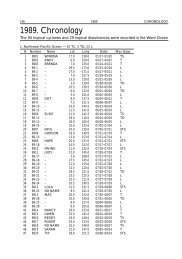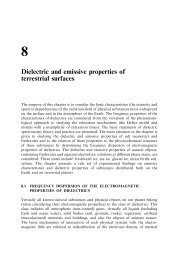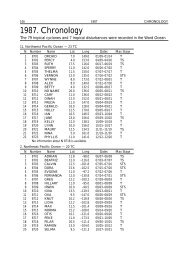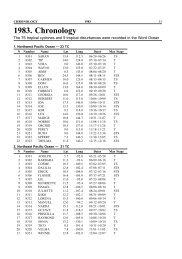Dear Dr. Pu, Thank you very much for your Decision Letter. I ...
Dear Dr. Pu, Thank you very much for your Decision Letter. I ...
Dear Dr. Pu, Thank you very much for your Decision Letter. I ...
Create successful ePaper yourself
Turn your PDF publications into a flip-book with our unique Google optimized e-Paper software.
<strong>Dear</strong> <strong>Dr</strong>. <strong>Pu</strong>,<br />
<strong>Thank</strong> <strong>you</strong> <strong>very</strong> <strong>much</strong> <strong>for</strong> <strong>you</strong>r <strong>Decision</strong> <strong>Letter</strong>.<br />
I prepared replies to both Reviewers and slightly changed the text of manuscript<br />
(marked by bold font).<br />
Sincerely <strong>you</strong>rs,<br />
Yuri Yermolaev<br />
=-=-=-=-=-=-=-=-=-=-=-=-=-=-=-=-=-=-=-=-=-=-=-=-=-=-=-=-=-=-=-=-=-=-=-=-=-=-=-=<br />
From: jgr-spacephysics@agu.org <br />
To: yermol@iki.rssi.ru <br />
Date: Tuesday, March 4, 2008, 6:11:27 AM<br />
Subject: 2008JA013040 (Editor - Zuyin <strong>Pu</strong>): <strong>Decision</strong> <strong>Letter</strong><br />
Files: Ñîîáùåíèå.html<br />
--====----====----====----====----====----====----====----====----====----===--<br />
Manuscript Number: 2008JA013040<br />
Manuscript Title: Comment on "Geoeffectiveness of halo coronal mass ejections"<br />
by Gopalswamy, N., S. Yashiro, and S. Akiyama"<br />
<strong>Dear</strong> <strong>Dr</strong>. Yermolaev:<br />
Below and/or attached are two reviews of the above manuscript. Both reviewers<br />
find this work significant and potentially suitable <strong>for</strong> publication in the<br />
Journal of Geophysical Research - Space Physics, but they have a number of<br />
comments that first need to be carefully addressed.<br />
If <strong>you</strong> wish to submit a revised manuscript, please do so by May 2, 2008. Please<br />
include a Response to Reviewer letter that gives complete, detailed responses to<br />
the reviewers' comments, indicating clearly which specific comment is being<br />
addressed by each response, and also stating <strong>for</strong> each response what, if any,<br />
changes have been made to the manuscript. If <strong>you</strong> need an extension of this<br />
deadline, contact our office be<strong>for</strong>e that date; a longer turnaround period may be<br />
granted under some circumstances. If <strong>you</strong> do not plan to submit a revision,<br />
please let us know as soon as possible.<br />
Please review the Important Links to JGR In<strong>for</strong>mation attached below be<strong>for</strong>e<br />
uploading <strong>you</strong>r revised manuscript. When <strong>you</strong> are ready to submit <strong>you</strong>r revision,<br />
please use the link below.<br />
http://jgr-spacephysics-submit.agu.org/cgibin/main.plex?el=A1Z7DluQ5A4BHdX1I6A9TzhcaVKMVykcZ9RqUPyqwZ<br />
<strong>Thank</strong> <strong>you</strong> <strong>for</strong> choosing the Journal of Geophysical Research - Space Physics.<br />
Sincerely,<br />
Zuyin <strong>Pu</strong><br />
Editor, Journal of Geophysical Research - Space Physics<br />
Reply to Reviewer #1<br />
--------------------<br />
I thank Reviewer <strong>for</strong> consideration of the manuscript and useful comments. Some<br />
of them are accepted. However I can not agree with some remarks and would like<br />
to explain my point of view and make several comments (see below). I marked my<br />
comments by YY.<br />
Review of "Comment on "Geoeffectiveness of halo coronal mass ejections" by<br />
Gopalswamy, N., S. Yashiro, and S. Akiyama"" by Yuri Yermolaev [Comment<br />
MS#2008JA013040] and Reply by Gopalswamy, N., S. Yashiro, and S. Akiyama
This exchange continues a series of papers and comments on other papers by<br />
Yermolaev on the topic of halo CMEs and their geoeffectiveness in causing<br />
geomagnetic storms. In his short comment, he criticizes Gopalswamy et al. <strong>for</strong> 1)<br />
not contrasting their high geoeffectiveness rate of halo CMEs with the lower<br />
rates of some other published results, including Yermolaev's, and 2) using an<br />
incorrect method to assemble their list of frontside halo CMEs.<br />
At the heart of this comment is that Gopalswamy used a commonly accepted method<br />
of identifying SOHO LASCO frontside halo CMEs, those most likely to be aimed at<br />
Earth from SOHO's L1 position. This is to assume that any frontside CME will<br />
have visible disk activity associated with its launch, and any halo CMEs that<br />
are not associated with disk activity are assumed to be aimed anti-Earthward, or<br />
on the backside. Yermolaev points out that recent studies by Zhang et al. [2007]<br />
and Schwenn et al. [2005] found that a few major storms could not be identified<br />
with frontside halos and, indeed, historically there have been so-called<br />
"problem storms" <strong>for</strong> which NO frontside surface activity could be found. A wellstudied<br />
example was the January 1997 storm which had a faint halo CME associated<br />
with a <strong>very</strong> weak surface event (e.g., Webb et al., 1998). Cane and colleagues<br />
have also found that some ICMEs or ejecta at Earth, even some with magnetic<br />
clouds, could not be associated with halo CMEs at<br />
the Sun [Cane Richardson, 2003]. Thus, Yermolaev concludes that Gopalswamy et<br />
al.'s procedure is "incorrect" because they misidentify some frontside halos as<br />
backside, and, there<strong>for</strong>e, their list and conclusion on geoeffectiveness are also<br />
"incorrect".<br />
YY. <strong>Thank</strong>s <strong>for</strong> useful reference. I included it in the list of References.<br />
Gopalswamy et al. reply that Yermolaev failed to show any specific examples of<br />
misidentifications from their list, and they stand by their original conclusions.<br />
A key point is that they only use full halo CMEs and not partial halos as was<br />
done in some of the other studies. They provide compelling evidence that, as an<br />
active region and its associated CMEs rotate from the east limb across the disk<br />
to the west limb, the appearance of the CMEs changes from narrow, to partial<br />
halos to full halos, then back again. I tend to agree with Gopalswamy et al. on<br />
all these points. As long as one is careful to state what their selection<br />
criteria are, then one cannot label their results as "incorrect". Yermolaev has<br />
a good point about problem events but does not provide any compelling evidence<br />
that Gopalswamy et al. have misidentified any backside halos that were actually<br />
frontside with no surface activity.<br />
YY. In my comment I specified an obvious logic mistake of authors during their<br />
interpretation of observations: an absence of observational facts of disk<br />
activity is not a sufficient condition that “frontside halo CMEs without disc<br />
activity” events have been excluded from the frontside list and included in the<br />
backside list.<br />
Does the referee agree with this statement?<br />
Examples in papers by Zhang et al. confirm this statement.<br />
It is important to emphasize that the method used by Gopalswamy et al. depends<br />
on the used instruments of observations. Thus, the list of events defined by<br />
this method depends on instruments and will vary with development of<br />
experimental techniques.<br />
I added a text (bold font) in the manuscript.<br />
It is my opinion that the comment and reply can be published nearly as is,<br />
though the editor may wish to permit Yermolaev a response to Gopalswamy et al.'s<br />
reply. Both documents have some spelling errors.<br />
YY. If I understand correctly I should not significantly change the text of my<br />
comment. As <strong>for</strong> spelling errors, English is not my native language and I would<br />
be <strong>very</strong> grateful if the Editor office could help me improve text of my<br />
manuscript.<br />
New Reference:
Cane, H.V. and I.G. Richardson, JGR, 108, A4, 2003.<br />
YY. Accepted.<br />
Sincerely <strong>you</strong>rs,<br />
Yuri Yermolaev<br />
Reply to Reviewer #2<br />
--------------------<br />
I thank Reviewer <strong>for</strong> consideration of the manuscript and useful comments. Some<br />
of them are accepted. However I can not agree with some remarks and would like<br />
to explain my point of view and make several comments (see below). I marked our<br />
comments by YY.<br />
Gopalswamy et al. [2007] obtained a high rate of geoeffectiveness, 71%, <strong>for</strong> 229<br />
"frontside halo" CMEs observed between 1996 and 2005, which is significantly<br />
higher than the geoeffectiveness of 40% obtained by Kim et al [2005] <strong>for</strong> 305<br />
"frontside halo" CMEs between 1997 and 2003.<br />
Kim et al.' result is consistent with some studies [Wang et al., 2002; Yermolaev<br />
and Yermolaev, 2003a; 2003b].<br />
Based on significant different rate between Gopalswamy et al and those mentioned<br />
here, the author of the comment paper thought<br />
that Gopalswamy et al.' rate was overestimated, and the reason was "the<br />
selection method used by Gopalwamy et al is incorrect".<br />
YY. I made my conclusions in the manuscript not on the basis of “significant<br />
different rate between Gopalswamy et al and those mentioned here” but on the<br />
basis of an obvious logic mistake of authors during their interpretation of<br />
observations: an absence of observational facts of disk activity is not a<br />
sufficient condition that “frontside halo CMEs without disc activity” events<br />
have been excluded from the frontside list and included in the backside list.<br />
I added a text (bold font) in the manuscript.<br />
As the author mentioned that Gopalswamy et al. [2007] used a "harder criteria of<br />
event selection" because the number of "frontside halo" CMEs selected by<br />
Gopalswamy et al. between 1996 and 2005 (10 years) was LESS than the number of<br />
"frontside halo" CMEs selected by Kim et al. between 1997 and 2003 (7 years). It<br />
means that the definition of "frontside halo" CMEs" used by Gopalswamy et al.<br />
must be different from that by Kim et al.<br />
What is the difference of the definitions between the two papers?<br />
YY. * Sorry. The purpose of my comment was to discuss lacks of the method used by<br />
Gopalswamy et al., instead of Kim et al.. There<strong>for</strong>e, to discuss the content of<br />
my comment, it is necessary to discuss a following question: Does the referee<br />
agree with statement presented in my previous paragraph?<br />
The author thought Gopalswamy et al. [2007] incorrectly define FRONTSIDE and<br />
BACKSIDE halo CMEs, and thus got his three conclusions. However, if the author's<br />
point of view was correct, both the number of CMEs and the rate of<br />
geoeffectiveness could be changed at most 10% due to exclusion of the solar<br />
events that generate the 10% large magnetic storms (problem storms). This kind<br />
of change cannot be used to explain the significant difference in the CME number<br />
and the geoeffective rate.<br />
YY. It is not correct estimations. Zhang et al. obtained 10% of “problem storms”<br />
<strong>for</strong> strong magnetic storms with Dst < -100 nT while Gopalswamy et al. considered<br />
slighter storms with Dst < -50 nT which may correspond with slighter solar<br />
events and number of such events <strong>for</strong> “problem storms” is larger in 2-3 times. In<br />
this case Gopalswamy et al. could easily obtain 70-percent geoeffectiveness of<br />
CMEs instead of 50-percent one.
Actually the definition of FRONTSIDE in Gopalswamy et al.<br />
[2007] is basically the same as in Kim et al. [2005], i.e.,<br />
those halo CMEs that have disk (or near-surface) activity associated.<br />
YY. What is a source of this statement? Is it Reviewer’s point of view ?<br />
See also my 2 nd reply here (marked by *).<br />
The major difference between Gopalswamy et al. [2007]<br />
and Kim et al. [2005] (and Wang et al., 2002; Yermolaev and Yermolaev, 2003a;<br />
2003b) is in the definition about "HALO" CMEs. In Gopalswamy et al. [2007] the<br />
halo CME was defined as CMEs with apparent (sky plane) width of 360 degrees, but<br />
in Kim et al. [2005] it was defined as CMEs with apparent width greater than 120<br />
degrees.<br />
That is why the number of frontside halo CMEs between 1996 and 2005 being<br />
significantly less than the number between 1997 and 2003.<br />
YY. I should note that the method used by Gopalswamy et al. is incorrect both<br />
<strong>for</strong> full halo CMES and <strong>for</strong> partial halo CMEs. See my 2 nd reply here (marked by<br />
*).<br />
The halo CMEs defined as CMEs with apparent width greater than 120 degrees may<br />
be further classified into FULL and PARTIAL halo CMEs on the basis of apparent<br />
widths equal to and less than 360 degrees, respectively.<br />
Statistical studies (e.g., Zhao Webb, 2007) show that about one third of halo<br />
CMEs are full halo CMEs, and two third are partial halo CMEs; about three fourth<br />
of frontside full halo CMEs and one fourth of frontside partial halo CMEs have<br />
geostorms associated. It can be calculated that the number of frontside halo<br />
CMEs is ~687 between 1996 and 2005, and the rate of the frontside halo CMEs is<br />
~40% using the data (71% and 229) provided in Gopalswamy et al.<br />
YY. I could not find a paper corresponding to “Zhao Webb, 2007”. The purpose<br />
of my comment was to discuss lacks of the method used by Gopalswamy et al..<br />
Please explain what new to my comment the results of paper by Zhao and Webb,<br />
2007 give.<br />
Sincerely <strong>you</strong>rs,<br />
Yuri Yermolaev<br />
--------------------IMPORTANT PUBLICATION INFORMATION---------------------<br />
To ensure prompt publication:<br />
1. Follow file <strong>for</strong>mat guidelines<br />
2. Provide a color option<br />
3. Combine figure parts or provide separate captions<br />
4. Provide copyright permissions <strong>for</strong> reprinted figures and tables<br />
5. Sign and send copyright transfer agreement<br />
6. A <strong>for</strong>mal estimate will be sent to <strong>you</strong> a few weeks after acceptance.<br />
For in<strong>for</strong>mation on all of the above items, see Tools <strong>for</strong> Authors at<br />
http://www.agu.org/pubs/inf4aus.html.<br />
If <strong>you</strong> have any questions, reply to this e-mail.<br />
A manuscript tracking tool is available <strong>for</strong> <strong>you</strong> to to track the status of <strong>you</strong>r<br />
article after acceptance:<br />
http://www.agu.org/cgi-bin/ms_status/ms_status.cgi<br />
************************************END*************************************<br />
=-=-=-=-=-=-=-=-=-=-=-=-=-=-=-=-=-=-=-=-=-=-=-=-=-=-=-=-=-=-=-=-=-=-=-=-=-=-=-=

















